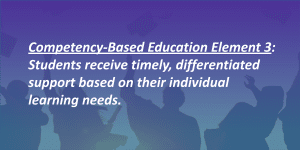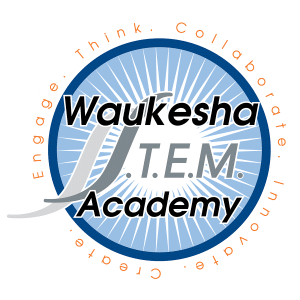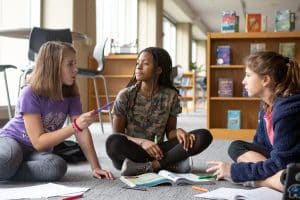CBE Starter Pack 3: Timely, Differentiated Support
CompetencyWorks Blog
When educators begin to explore competency-based education (CBE), the CompetencyWorks Initiative is a key place to find information and ideas. It can be overwhelming to know where to start and the goal of this series of “CBE Starter Packs” is to help readers find their entry points. Each post focuses on one of the seven elements of the Aurora Institute’s 2019 CBE Definition.

Student-centered, competency-based systems are designed to ensure every student is working toward successful attainment of competencies at a personalized, responsive pace that leads them toward timely graduation. Competency-based districts and schools demonstrate the capacity to monitor growth of every single student’s learning and respond quickly when students are not progressing. The monitoring processes communicate progress with transparency, provide data in real time, reinforce the process of learning, and drive continuous improvement. Schools need to meet students where they are in their zones of proximal development to help them master learning targets and build the competencies they need for college, career, and life. 
When schools commit to ensuring that every student can succeed and recognize that students have different knowledge, skills, and life experiences, they quickly find that a one-size-fits-all approach will not work. Instead, schools need to be responsive, providing the right support at the right time. This includes making learning targets explicit and ensuring learning topics are on a progression (also called a continuum). Learning targets should also be known and meaningful to students. Instructional strategies include organizing instruction at students’ performance levels, unbundling grade-level standards into a learning continuum, prioritizing the most important content and skills, and/or anchoring instruction to standards and learning targets while engaging strategies to fill in gaps to build the prerequisite knowledge with scaffolding.
Some worry that “meeting students where they are” is code for lowering the rigor of instruction and that it might perpetuate learning gaps. On the contrary, meeting students where they are is about equity because it is highly aligned with learning sciences and equitable practice. A critical aspect of responsiveness is maintaining consistent expectations for proficiency and monitoring student pace to ensure students are receiving effective instruction and support to demonstrate proficiency.
Transparency—created through the practices of defining explicit learning targets, making it clear to all where students’ current performance is at, and using data to guide learning—reduces the risk of sending mixed messages or false signals about student learning. The wealth of data on student learning generated through competency-based education is powerful in providing feedback to students, families, and educators. For educators, this abundance of data will help educators reflect on their own effectiveness and can lift up potential areas of bias as well as highlight areas for improving instruction.
What does timely, differentiated support look like?
Designing to provide each student with timely, differentiated support means 1) being clear about the learning goals and pathways in your system and 2) fostering relationships with each learner to know who they are and collaborate with learners to personalize their learning. These examples illustrate how real schools do this in practice, in ways that fit their own local communities.
Example: Noble High School
Serving around 1200 students in grades 8-12 in Maine, Noble High School is a proficiency-based school designed around providing multiple support strategies to build relationships and meet the needs of all students to master learning outcomes for a rigorous and personalized education. Students are heterogeneously grouped in Vertical Learning Academies (VLA) where they stay, along with their teachers who work as interdisciplinary teams, through their years at Noble. Responsive strategies include clear learning goals within a proficiency-based system, personalized learning practices, and collaborative structures for professional learning and analyzing data.

For 8th and 9th grade students, the Building Assets, Reducing Risks (BARR) process is another big component in the support system. Every student’s progress is reviewed each week. Every other day during a team meeting, the VLA team identifies concerns and students who need support, whether academically or social-emotionally. These students’ cases are brought to a larger meeting that includes counselors and administrators to create support plans. Some cases also are discussed in another meeting that includes other support staff, such as social workers. Curriculum modules—on topics ranging from grief and loss to diversity—rotate through each content area once a week and intentionally build positive relationships and students’ social-emotional assets. A review process similar to BARR also serves students in grades 10-12. These data-driven conversations and problem-solving sessions further inform relationship-building and instruction with students within the academies.
Daily and ongoing routines further allow for timely support. KnightTime is a combination of an advisory program and intervention designed to provide a structure to support students and help them achieve success. The goal is to have students become responsible for their learning while also becoming well known by an adult in the building. Monday is advisory and planning time where each student, with their advisor, plans their KnightTime schedule for the week and books locations. Students and teachers can also pre-book time prior to Mondays.
Learn more: CompetencyWorks site visit post: Noble High School: Creating Timely, Differentiated Supports; article about the BARR program; Noble HS is one of three sites featured in the course, Competency-Based Education: The Why, What, and How, which includes videos and other artifacts.
Example: Waukesha STEM Academy
Waukesha STEM Academy in Wisconsin, serving learners in grades 6-8, wanted students, teachers, and parents to be able to monitor students’ academic growth and progress on a learner continuum that stretched from the entering competency levels of students to college or career-readiness. They envisioned a continuum to monitor a student’s pace of progression. With real-time access to data on student progress on the continuum, all stakeholders can be ready to provide the needed supports. The students themselves are key stakeholders who need to be able to understand and advocate for what they need.
The schedule includes structures and routines for real-time support within the CBE system. All students have an advisory group which meets multiple times daily. CONNECT and FLEX are additional times, built into the schedule, when students and staff have time to personalize learning to needs as they arise. CONNECT, which happens concurrently during lunchtime every day, provides an hour for students to touch base with staff as needed or as requested. Twice a week, FLEX is a process that allows students to go to whatever teacher and course they need extra help or extra time with to complete their projects. Homework Club is available three times a week for extra help after school, with students working in a math lab or literacy lab as needed. Over a longer cycle, three times a year, student-led conferences and STEM Student Showcases engage parents in conversation with students and teachers about students’ learning.
The combination of a variety of real-time, personalized learning supports and a transparent system of learning goals allows Waukesha STEM Academy to meet the needs of their learners with timely, differentiated supports.
Learn more: The four-part CompetencyWorks blog series on Waukesha STEM Academy includes Creating a Learner-Driven System, Personalizing Instruction and Learning Experiences, Rethinking Space, Time, and Reporting, and Waukesha STEM Academy’s Journey from ABC to the Learner Continuum.
What to Look for in the Student Experience
Can you see these CBE “look fors” related to timely, differentiated support in the examples above?

- Students are able to tell you what they are working on (and at what level), what supports they need, and how they will know when they reach proficiency.
- Students have multiple opportunities to access extra support and instruction.
- Student learning is monitored along a continuum that spans multiple grade levels rather than completion of grade-level standards within a year or course.
- Students are not tracked or segregated by perceived ability and behavioral compliance.
What school policies and practices support timely, differentiated support?
- A clearly articulated pedagogical philosophy or set of beliefs drive instruction. Professional learning gives educators the opportunity to develop the skills necessary to enact the shared pedagogical philosophy.
- Teachers plan for meeting students where they are by organizing and making available learning tasks and/or units that span the full range of competencies students need to attain over the course of their learning.
- Learning experiences and instructional strategies are designed to meet the needs of diverse learners and take into consideration that students start with different sets of academic knowledge and skills, social and emotional skills, and life experiences.
- Practices are learner-centered and culturally responsive, including, but not limited to, communication of high expectations, flexible and heterogeneous grouping, teaching methods that encourage active learning, student-driven discourse, and small-group instruction.
- Data is used to monitor student growth in academic domains, deeper learning and higher order skills, and lifelong-learning skills.
Learn More
Dig Into the Research and Background Information
- The Learning Edge: Supporting Student Success in a Competency-Based Learning Environment is an issue brief that explores how practitioners are designing school culture, embedding supports, and organizing resources to ensure students are progressing and on pace.
- Meetings Students Where They Are provides an in-depth exploration of the relational, pedagogical, and structural dimensions of meeting students where they are in K-12 competency-based education systems. The report provides strategies for practitioners to maximize the potential of each student’s unique skills and interests.
- Making Mastery Work: A Close-Up View of Competency Education documents the work and learning from the 18-month, Proficiency-Based Pathways Project grants awarded in 2011 to seven projects representing a range of competency education models. The theme of student support is explored specifically and interwoven into the analysis.
- The blog post, Trends and Analysis of Learning Sciences Literature, synthesizes the research and resources from the report, Aligning Education Policy with the Science of Learning and Development. Common trends that can be used to design instruction and responsive supports emerge from the findings on how humans develop and learn.
Explore Examples and Resources

There are many blog posts, Aurora Institute Symposium sessions, webinars, toolkits, and organizations contributing to our knowledge and practice of effective personalized instruction. Here are a few to get you started.
- A sampling of CompetencyWorks site-visit blog posts about responsive supports include: Ensuring Responsiveness to Student Needs at Learn4Life Schools; Henry County Schools: Ensuring Success for Each Student; Strategies for Responsive Pacing at the Success Center.
- This 20-minute video from #AuroraSymposium2021 explores Whole-Child Design: How To Use The Science of Learning and Development to Redesign Classrooms, Schools, and Systems and Accelerate Healthy Development, Learning, and Thriving.
- The blog post, Personalized, Competency-Based Learning Can and Should Replace Tracking – Here’s Why, explains how CBE directly addresses many problematic aspects of tracking.
- The CBE Design Principle 3 Rubric, focused on structures for support and monitoring, is a resource from the book, Unpacking the Competency-Based Classroom, in which Vander Els and Stack offer a roadmap for transforming schools in pursuit of greater equity through competency-based learning.
Read the Full Supporting Design and Equity Principles
Designing for equity and quality implementation that is inclusive and responsive to the local community is at the heart of competency-based education. The information above is synthesized from key Aurora and CompetencyWorks publications, in particular, Designing for Equity: Leveraging Competency-Based Education to Ensure All Students Succeed (see also this blog post that offers a short overview) and Quality Principles for Competency-Based Education.
Key Principles for Timely, Differentiated Supports:
- Equity Principle (p. 23): Monitor and Respond to Student Progress, Proficiency, and Pace
- Equity Principle (p. 29): Develop Shared Pedagogical Philosophy Based on Learning Sciences
- Quality Principle #6 (p. 54): Base School Design and Pedagogy on Learning Sciences
- Quality Principle #9 (p. 66): Ensure Responsiveness
Get Started
Reflecting on your own or with your team, school, district, and/or community is a great way to identify priorities and current assets to build on in providing timely, differentiated support to each student.
- What processes and strategies are used to measure and monitor student growth based on student performance levels?
- What processes monitor and respond when student pace is slower than anticipated?
- What types of strategies are in place to reinforce a focus on responsive learning and growth (in contrast to the grade-level focus of state accountability systems)?
- What strategies are in place to uncover bias; increase the use of effective strategies to engage, motivate and help students learn; and ensure that historically underserved students are learning and growing in equitable ways?
- In what way are educators supported in differentiating and personalizing learning based on the learning sciences in order for students to reach common, rigorous educational outcomes and discover talents and interests?
Once you have an idea of strengths to build on or areas in need of new ideas, what will you do next, both in the short term (think: trying one new thing) and in the longer term (think: strategic planning and systems change)? Hopefully the resources above give you models, tools, and ideas to adapt to your context or inspire new approaches that work for your community.
Good luck, and if you are looking for additional resources, try browsing past posts on the CompetencyWorks Blog, with its many stories of lessons learned by innovators and early adopters from across the field of K-12 competency-based education.
Find Other Starter Packs
- CBE Starter Pack 1: Students are Empowered Daily
- CBE Starter Pack 2: Meaningful Assessment
- CBE Starter Pack 4: Progress Based on Mastery
- CBE Starter Pack 5: Learn Actively With Varied Pathways and Pacing
- CBE Starter Pack 6: Equity Strategies Drive Culture, Structures, and Pedagogy
- CBE Starter Pack 7: Establish Rigorous, Common Expectations with Meaningful Competencies
Stay tuned for future posts!
Laurie Gagnon is the Aurora Institute’s CompetencyWorks Program Director.